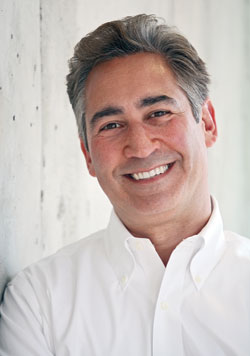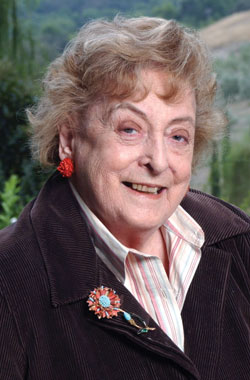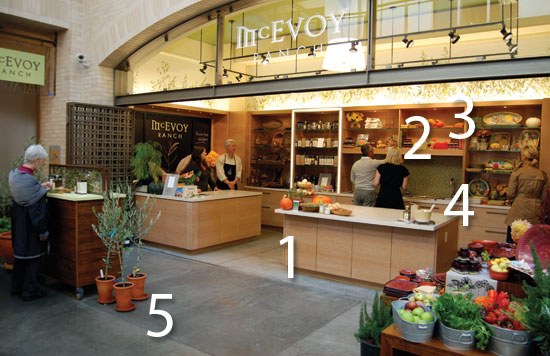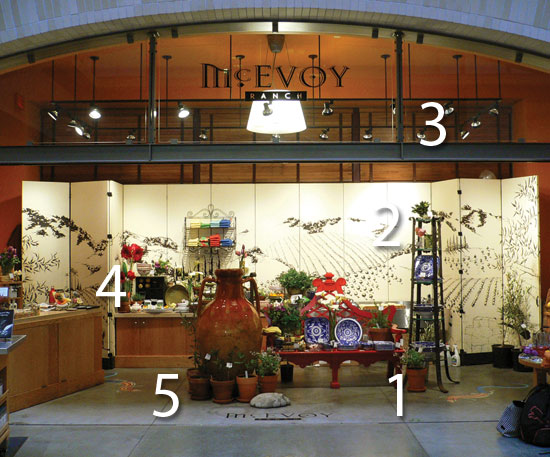Translating Sustainable Practice to Sustainable Design
Article Resources
Michael Bodziner
Gensler
415.433.3700
Gensler.com
Nan McEvoy
MvEvoy Ranch, The Ferry Building Shop
415. 291.7224
McEvoyRanch.com
When Michael Bodziner was first assigned to redesign the McEvoy ranch’s retail store in San Francisco, he thought he had a specific task to accomplish: to capture the essence of the nearly 80 acres of olive trees at the McEvoy Ranch in Marin County, CA and translate that to the San Francisco store. When he and his design team visited the ranch to get a feel for the place however, he found that the essence of the ranch was not in the trees but in the kitchen where everyone gathered for lunch.
Bodziner is the principal and co-founder of the retail division of design firm Gensler. “It became apparent to me that there was really something there. [The kitchen] was the heart and the soul of the ranch,” says Bodziner, an LEED accredited professional. LEED, which stands for Leadership in Energy and Environmental Design, is a set of standards for environmentally sustainable construction developed by Washington, D.C.-based U.S. Green Building Council. In the McEvoy kitchen, chefs prepared meals mostly from produce from the ranch, and ranch workers gathered for lunch. “It was a real piece of Americana,” recalls Bodziner. “You almost expect someone to ring a bell to announce lunch.”
The heart of the redesign
 After that visit to the ranch, Bodziner shifted focus a bit. He was now sure he wanted to translate the warm kitchen experience he saw at the ranch to the San Francisco store. The new store design would capture the spirit of the ranch’s kitchen—it would include “a real piece of Americana.”
After that visit to the ranch, Bodziner shifted focus a bit. He was now sure he wanted to translate the warm kitchen experience he saw at the ranch to the San Francisco store. The new store design would capture the spirit of the ranch’s kitchen—it would include “a real piece of Americana.”
So Bodziner and his team took the essence of the McEvoy Ranch kitchen and used it as the centerpiece of the redesign of the 258-square-foot store. The walls, which are made like kitchen cabinets, display the store’s products. The flagship product—the extra-virgin olive oil—is given a permanent home on the prominent back wall. A lithe frame was created around the section that houses the olive oil, to draw the customer’s attention to it. “This (olive oil) is really at the core of the brand,” says Bodziner.
The walls also feature murals of olive trees, to give an impression of looking out at the ranch.
Why redesign?
 Founded in 1991, McEvoy Ranch is a producer of certified organic products, which, apart from the olive oil and seasonal produce, includes a line of body care and gift products. The company has 18,000 trees on 80 acres of its 550-acre ranch. In 1994, the company decided to go organic, which means that the olive trees are grown without any chemical pesticides or herbicides, and that sheep graze on the grass. The process of going organic took three years, says Nan McEvoy, the founder and CEO of McEvoy Ranch. She says the San Francisco store is the company’s opportunity to bring the atmosphere of the ranch to the city.
Founded in 1991, McEvoy Ranch is a producer of certified organic products, which, apart from the olive oil and seasonal produce, includes a line of body care and gift products. The company has 18,000 trees on 80 acres of its 550-acre ranch. In 1994, the company decided to go organic, which means that the olive trees are grown without any chemical pesticides or herbicides, and that sheep graze on the grass. The process of going organic took three years, says Nan McEvoy, the founder and CEO of McEvoy Ranch. She says the San Francisco store is the company’s opportunity to bring the atmosphere of the ranch to the city.
Retailers are sometimes not sure about when to redesign, but for McEvoy Ranch, it was part of a natural process—keeping up with the growth of the company. When the needs of the company grew, the old space just didn’t seem to be able to satisfy them.
The company now had a wider product offering—a range of olive oil-based personal care products called 80 acres, and artisanal gifts, tabletop accessories, handcrafted soaps, produce and flowers from their organic gardens. Some other products of the company are Meyer Lemon Marmalade, Mille Fleur Honey and Tuscan Table Olives.
The old design did not leave much room for storing stock, nor did it have effective ways to display the merchandise. “Before the redesign we would run out of olive oil because we could only store a limited amount at the Ferry Building,” McEvoy says. The old design also did not allow for seamless expansion into the body care product line, and 80 Acres struggled to find a place of its own in the space. Without vertical shelving, says Bodziner, it was difficult to accommodate the growing range of products.
Also, the tasting events, an integral part of the store’s customer outreach, needed to be accommodated better. “So if you think about throwing a party in your home—you have a kitchen with a sink, refrigerator, freezer—and you have tables. We didn’t have any of that,” McEvoy says.
Sustainable design
In keeping with the philosophy of the company, the store design had to be as green as possible. “They (McEvoy Ranch) asked us to be as sustainably conscious as we could be,” says Bodziner. “And there were quite a few things that we did.”
Gensler and McEvoy Ranch put their heads together to create what Bodziner calls a “Level 2” green design. Many of the materials they used—such as the glass and tile—were either recycled, or had some recycled content in them. They also used FSC (Forest Stewardship Council)-certified white oak and olive woods.
Power-saving LEDs form the lighting in the store, and wherever possible, existing material was reused. Also, Bodziner says, Gensler partnered with people who are environmentally conscious—like Berkeley Mills, also in San Francisco, who made the furniture and cabinets for the store.
Some of the features—like the usage of reclaimed barn siding for the signage—also lent an air of authenticity. “The way we burnt the lettering in the signage looked like it came directly from the ranch,” says Bodziner.
Shades of green
The redesign was implemented last fall just as the economy was taking a turn south. But that did not deter McEvoy. “We always think of the big picture, long-term,” she says. Bodziner says that “going green” was no longer a decision; it was just a question of how green you wanted to go.
“It (green design) is absolutely the way of the present and definitely the way of the future,” says Bodziner. “I don’t think any of us in any line of business can really afford not to take a sustainable approach to design.”
However, he says that businesses are often misguided about green initiatives, and think that one has to go “all the way” to become an environmentally conscious business. “There are different degrees of going green,” says Bodziner. A business can choose the most sensible environment-conscious options for its situation, he says. “Every client isn’t prepared to fully implement it (a totally green design) yet,” Bodziner adds, “but every step makes a difference.”
Also, Bodziner says, going green need not cost substantially more—it can be as low as 1% of the project cost for a LEED-certified project, including the documentation for certification. “As far as materials go, recycled content and low emitting products should not cost more, and are relatively easy to find,” he says.
Also, he says, “green” projects save money, improve productivity and strengthen employee attraction and retention. All Gensler projects have a basic level of sustainability—for instance, they all use low-VOC paints. However, clients can go in for as much sustainability as they are comfortable with. The level 2 that the McEvoy Ranch project falls under typically includes water conserving plumbing, a cool/green roof, and ambient lighting.
Other changes
For McEvoy, the best part of the redesign is the way it helps host more events at the store. Even better, the concept of the kitchen fits in well with the tasting events. “Even when you’re entertaining, everyone seems to gravitate towards the kitchen,” says Bodziner. “There are all these reasons why the concept [of the kitchen] felt perfect.”
The overall square footage of the store didn’t increase but the redesign created opportunities for vertical shelving, which also helped group similar products together. It also brought the products to a “shoppable height,” says McEvoy, implying that more products were now at a level where customers could easily see and reach for them. Storage capacity was doubled. The store also now features a small office area by the cash register.
Because the store always held tastings, there were three janitorial sinks in the space—these were mandated by California Health and Safety Code. Before the redesign, these sinks had no relationship to the overall design of the store. With the new “kitchen” design, they could be integrated into the design.
Bodziner’s favorite part of the store is a striking image—that of McEvoy’s hands holding an olive seedling. The image was blown up to 4 feet by 6 feet, and used as the backdrop for the cash register and office space. However, Bodziner wishes he was able to give his client one thing: a dishwasher. “Because of the dimensions of the space, we couldn’t offer them that luxury,” he says.
What you need to look out for
The new design has been receiving accolades from customers and retailers alike say Bodziner and McEvoy. “The greatest compliment is when the other retailers tell us what a good job we’ve done,” says Bodziner. McEvoy says she is very happy with the redesign, and has received several positive comments on how much brighter the store is.
McEvoy Ranch was one of the first stores to open in the Ferry Building Marketplace which focuses on food. The marketplace showcases small regional producers and specialty foods. It is highly conscious of environmentally responsible food production methods, and promotes artisan producers who practice sustainable methods of agriculture and production. The building won the 2008 Governor’s Environmental and Economic Leadership Award for its green initiatives.
Gensler has some advice for retailers looking to redesign their stores. Retailers often “see somebody else doing something and they want to do it,” and that should never be a criterion, Bodziner says. “Before approaching a design firm, a retailer really needs to dig deep and understand their brand,” he says. “The only way they can communicate it to the public is if they understand it completely.”
Changes
1. Kitchen islands allow for easier hosting of tasting events.
2. Shelving was added to showcase products at eye level and still have additional room for storage.
3. Softer murals with olive trees help recreate the ranch.
4. The must-have sinks are now more integrated into the store’s kitchen themed layout.
5. A kitchen theme, lighter lines and more storage were all elements of a successful store redesign.
Mouse over images below to view.


























